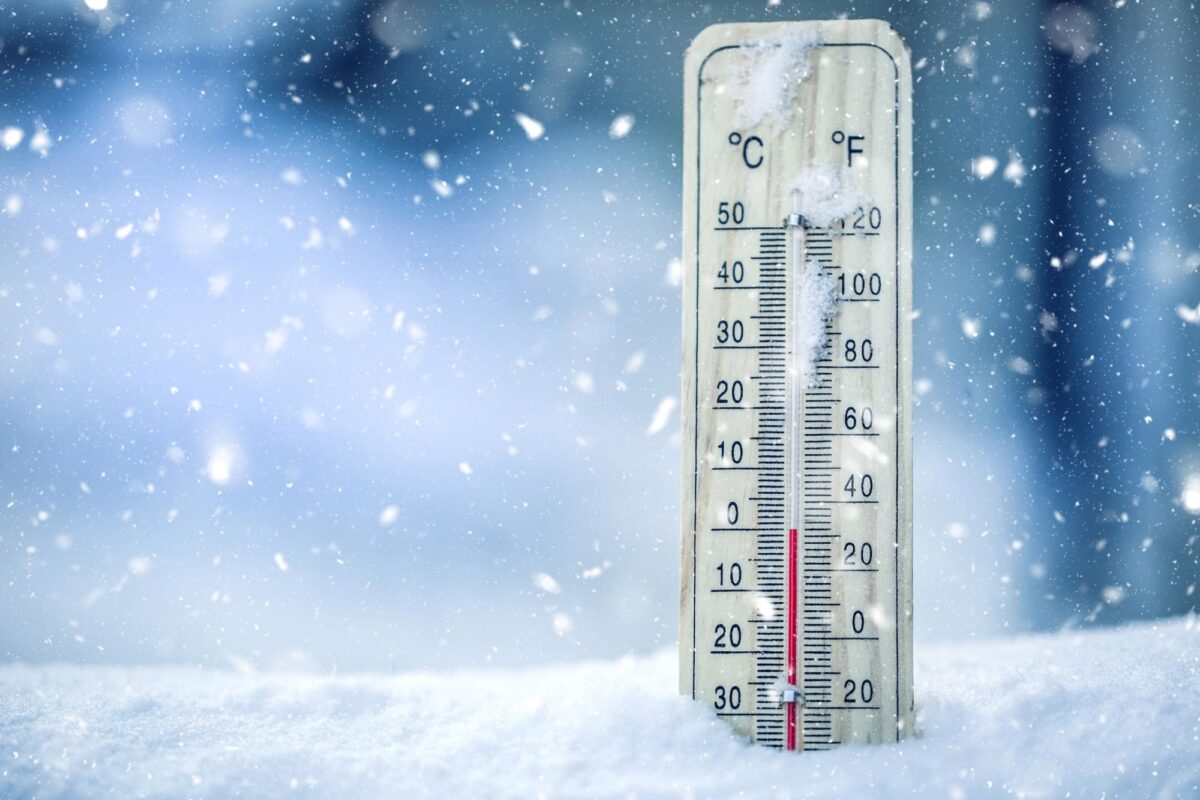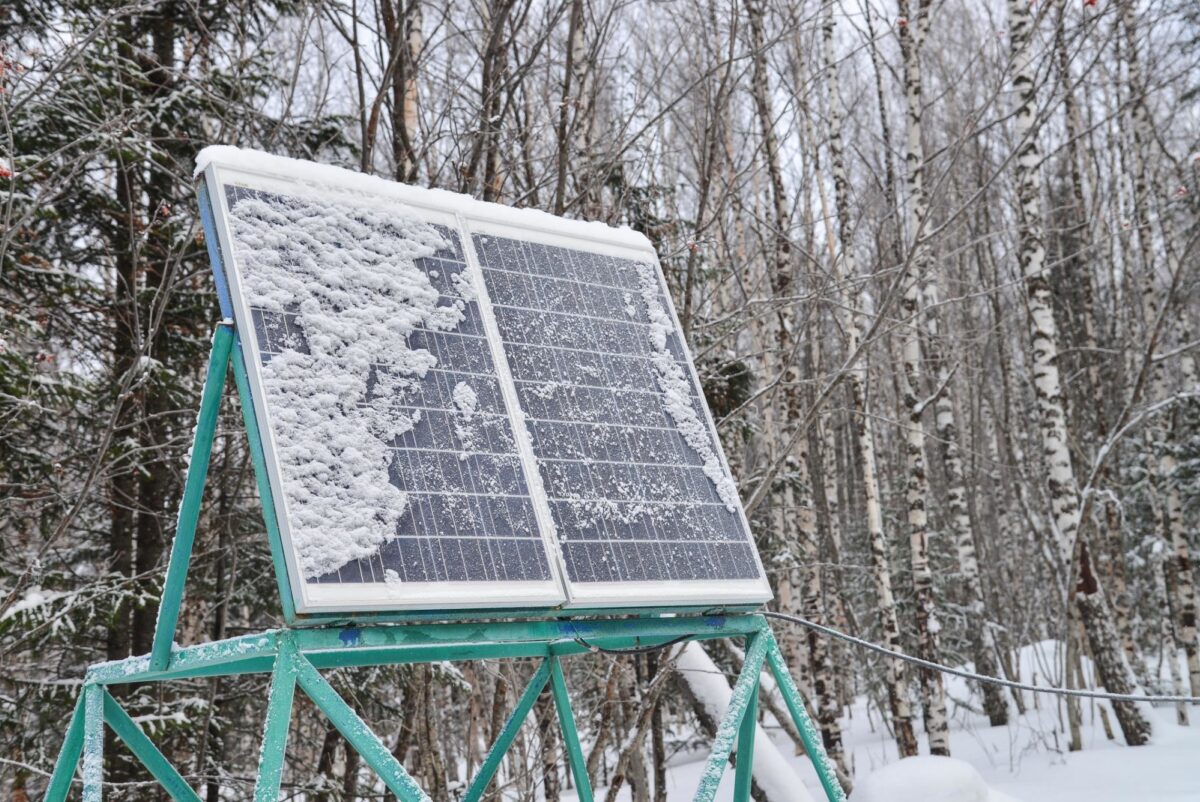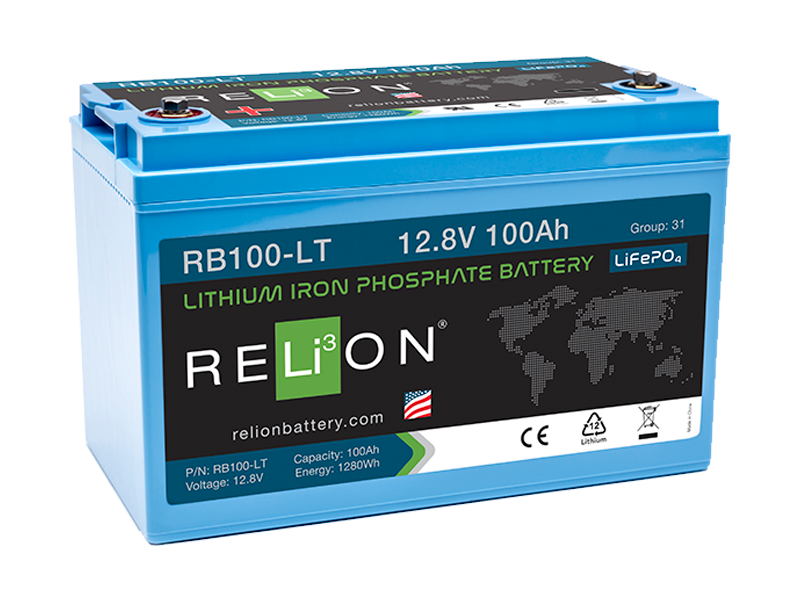When it comes to powering RVs, boats, golf cars and electric vehicles, or providing storage for solar power systems, RELiON’s lithium iron phosphate batteries offer several advantages over lead-acid batteries. They have longer life. They are lighter weight, and yet have a higher capacity. They require no maintenance and can be mounted in any direction. They also charge faster, and don’t require a full charge before they can be stored or used.
Lithium iron phosphate batteries can be safely discharged over a wide range of temperatures, typically from –20°C to 60°C, which makes them practical for use in all-weather conditions faced by many potentially cold temperature applications including RVs and off-grid solar. In fact, lithium-ion batteries have much better performance at colder temperatures than lead-acid batteries. At 0°C, for example, a lead-acid battery’s capacity is reduced by up to 50%, while a lithium iron phosphate battery suffers only a 10% loss at the same temperature.
The Challenge of Low-Temperature Lithium Charging

When it comes to recharging lithium-ion batteries, however, there’s one hard and fast rule: to prevent irreversible damage to the battery, don’t charge them when the temperature falls below freezing (0°C or 32°F) without reducing the charge current. Unless your battery management system (BMS) communicates with your charger, and the charger has the ability to react to the data provided, this can be difficult to do.
What’s the reason behind this important rule?
When charging at above-freezing temperatures, the lithium ions inside the battery are soaked up as in a sponge by the porous graphite that makes up the anode, the negative terminal of the battery. Below freezing, however, the lithium ions aren’t efficiently captured by the anode. Instead, many lithium ions coat the surface of the anode, a process called lithium plating, which means there’s less lithium available to cause the flow of electricity and the battery’s capacity drops. Charging below 0°C at an inappropriate charge rate, also causes the battery to become less mechanically stable and more prone to sudden failure.
The damage to the battery when charging at colder temperatures is proportional to the charging rate. Charging at a much slower rate can reduce the damage, but this is rarely a practical solution. In most cases, if a lithium-ion battery is charged below freezing even once, it will be permanently damaged and must be safely discarded or recycled.
In below-freezing conditions, without a BMS communicating to a charger that is programmed to reduce current when necessary, the only solution has been to heat the batteries to above freezing before charging, either by bringing them into a warmer environment or by wrapping them in a thermal blanket or placing a small heater near the batteries, ideally with a thermometer to monitor the temperature during charging. It’s not the most convenient process.
A New Lithium-Ion Battery System for Low-Temperature Charging
To solve the problem of charging and to make lithium-ion batteries safer and more practical for low-temperature use, RELiON has developed a new series of lithium iron phosphate batteries that can charge at temperatures down to -20°C (-4°F). The system features proprietary technology which draws power from the charger itself, requiring no additional components.

The entire process of heating and charging is completely seamless for the user. Simply plug the battery in to the regular lithium-ion charger and the internal heating and monitoring system takes care of the rest.
Because it takes time to heat the cells, the charging process in below freezing temperatures will take a little longer. For example, with the low-temperature RELiON RB100-LT 12Vv100Ah battery, it takes about an hour to warm from -20°C to +5°C before charging begins. Over a smaller temperature range, heating to a safe charging temperature happens proportionately faster.
RELiON’s low-temperature series look and operate exactly like our other batteries, with the same power and performance. They have the same charge time at above-freezing temperatures. They also have the same dimensions, configuration, and connectivity of its standard counterparts, so they are drop in replacements in applications that already use RELiON batteries. And they’re ideal upgrades for those who are still using lead-acid batteries in low-temperature environments.
An Ideal Lithium Battery Solution for Low-Temperature Applications

With RELiON’s LT Series batteries, users who sometimes face below-freezing temperatures can now enjoy the many benefits of a lithium battery without having to worry about warming the battery before charging. They feature the same size and performance as RELiON's standard lithium deep cycle batteries, but can safely charge when temperatures drop as low as -20°C using a standard charger. They're an ideal choice for use in RVs, off-grid solar, electric vehicles, and in any application where charging in colder temperatures is necessary.
Current products within the LT Series:
RB20-LT: Ideal for smaller cold weather applications such as remote monitoring, LED lighting, traffic control cameras and small solar energy systems.
RB52-LT: Compact and lightweight, but powerful, it's perfect for small solar energy systems, remote monitoring, kayaking, and other smaller applications where cold-temperature charging is needed.
RB100-LT: Deal choice for use in RVs, off-grid solar, electric vehicles, and in virtually any application where charging in colder temperatures is necessary.
thanks
I am in process of working with Sportsmobile to design a new camper. I want to have a Lithium system of approximately 1000ah. Can 10 RB100-LT be connected together to form the 1000ah system I am looking to have Sportsmobile install?
Carl - Unfortunately, the RB100-LT cannot be placed in “series” as of this time. It is a single module/battery solution. There are definitely ways to get to a 1000 Ah system. If you like, I could direct you to a salesperson to discuss your needs further.
I live on a region where temperatures in the winter regularly drop below -10F. If I leave the RV unattended (winterized) must I bring the batteries into a heated space, or can they over winter in the cold RV?
Edward – Yes, we would like to see the batteries live within 23F-95F if in long term storage postures. Also, if you don’t use the batteries over the “Winter” period, best practice suggests you charge the batteries every month or so if you can. If no charging is possible, store them at 50% SOC (state of charge).
" Unfortunately, the RB100-LT cannot be placed in “series” as of this time", is there any ETA on when it would be possible to use RB100-LT in series?
I really hate to point out the obvious to a battery "manufacturer", but connecting a battery in series will not increase the capacity (current rating, AH, whatever you want to call it) of the battery bank. Connecting in series will increase the voltage, deliverable current, or both (situational).
Connecting them in parallel however will increase the capacity of the battery bank, but not the voltage. Whether or not this will work with these batteries I cannot address because I am not familiar with their chargers, however I don't suspect the person answering the questions above is an expert either or they would have known the simple difference between series and parallel wiring.
When this article was posted five months ago, it stated that "more models in the Low Temperature series will be available soon." When will more models actually be available?
@ Nate. Think about what you wrote, adding another battery won't increase capacity??? Guess you don't understand Kwh. Connecting batteries in series will double the voltage and the Ah will remain the same however the capacity will double . The Kwh will double that is why it makes more sense to express the capacity of batteries in Kwh instead of Ah.
@Derek Nate is right. Carl asked if he could create a 1000Ah system using 10 100Ah batteries. This implies connecting the batteries in parallel. I don’t see why that shouldn’t be possible to be honest.
I do agree with you that battery capacity should be expressed using Wh in stead of Ah and voltage.
I don't think you can even run them parallel because the heater takes the battery out of balance. I need a 24volt version of this for wireless off-grid relays.
Nice Blog!!! Thanks for sharing your thoughts on this topic.
[Comment awaiting moderation]
I have a remote cabin and currently use lead acid batteries. The cabins sits unused for about 6 months and is not accessible for this period. Could you batteries work for our situation?
We use about 600 whrs a day and produce about 345 watts from our array so it’s a small system.
Do you have a battery confirmation for us?
Thanks
[Comment awaiting moderation]
@Tim Yes, we can work in that environment. Our batteries have a very low self-discharge rate, roughly 3% per month. So, them sitting idle for that period would only discharge them roughly 20%. Best practice would be to cycle them a few times during that period, but that isn’t mandatory. I am assuming this is a 12V system? If yes, our RB100 and RB200 could be options depending on your capacity requirements. It looks like they are modest. If not using the cabin, I would disconnect the solar charging when you leave for the six month period.
Hi, I maintain 30 summer cabins all completly off grid with solar and generators. I'm interested in the RB100-LT as they are the only model, besides the non-LT version, my supplier has available here in Canada. Plus I like the added piece of mind of the built in heater.
I didn't know there was an RB200 until I saw your last post... I was going to purchace 2x RB100-LT's and run them in parallel to get the 200ah at 12 volts. I'm even more confused now that I've read all these comments.
So is a parallel connection possible with 2 RB100-LT's? Will the BMS shut down one battery slightly before the other when a heavy load is applied and the batteries are near 90% discharged? I can see this being a big problem... Or not?
Is my only option the RB200-LT or bigger for my setup? I need a minimum of 200ah because I have a 2000watt inverter. My inverter would max out only one RB100-LT, I've been told by my supplier. I was going to buy these today but am glad I held off. Is there a simple explanation to the parallel question? Or do I need to seek help elsewhere.
Thanks
@Eric - Where are you located in Canada? Who is the supplier you are talking to? We do not have an RB200 LT model, only the RB200. It doesn’t have the heater and low temp charging capability. Yes, I would suggest 2 RB100-LT batteries in parallel if you need a 200Ah bank and the LT capability. Yes, typically up to (4) battery or a 400Ah bank. The collective bank will work as one battery, drawing each battery down equally. As long as the continuous amp requirement of the device is within what the total bank can support. You do get some additive benefits when putting the batteries in parallel. 75% of the combined continuous, peak and charging values can be used. Two RB100-LT batteries in parallel is your option for a 200Ah LT Series bank. You can contact our Canadian Sales Director, Brad Green, to assist further at bgreen@relionbattery.com.
I asked earlier and am still waiting.....[Comment awaiting moderation] I wanted to put 8 in parallel... (my coworker wanted to do three) but no response ... in your last comment you seem to indicate that two can be in parallel... What is story regarding running LT batteries in parallel???
Can LT batteries run in parallel?
@Glen - yes the LT Series can be run in parallel. We recommend no more than 4 LT batteries connected in parallel, however, if more capacity is needed you can connect up to 10 if you take some additional precautions. Make sure to use proper cabling, use fuses across the battery bank and check the voltage across the bank periodically to make sure each battery is within .05 Volts of each other. Rotating the string of batteries every so often is advantageous to change the positions as well. Let us know if you need anything else.
I wanted to confirm that A)- the LT heater consumes 10Amp , 120W. B)- heater will engage once temperature within the battery is below 0C and disengage at what temperature?
Thanks
@Max - Yes, it is a 10 amp heating element. Yes, it will engage when charging temps are below freezing (32F) and will stop heating when above (32F). In lab testing, it took 1 hour to raise the temperature from -4F to 41F as a point of reference.
Would it damage the battery if the temperature fell to -30 Celsius in my van?
@Simon - Our batteries are rated to discharge down to -4 degrees F. Storage temps are higher as those are “best practice” temps.
If you took the battery down to -30 C for a short time I don’t think it would cause damage. Charging at those temps would not be supported. Anything below 32 degrees F has to be charged at reduced rates. In sum, if the temps temporarily dropped to those levels you should be okay as long as you don’t charge the battery and keep the discharge side to -4F as much as possible.
Is Relion going to make a LT InSight Series battery? The new BMS would seem to really be advantageous to a low temp implementation...
Is any rechargeable battery available for -40 C discharge ?
12V100Ah or 12V200Ah.
@Kulkarni: Unfortunately, not rated to that low of a temperature. Only to -4F or -20C.
I currently have a 24 volt off grid system in my cabin with 4 -6 volt Deka 8L16 wired in series with about 420 amps. Our problem is they have frozen over winter time and have had to be replaced. I use a Magnum MS 4024 PAE inverter with a TriStar MPPT Solar controller, which Relion battery would work best in this application in winter sub freezing environment?
Hello I just purchased a couple of your 100AH LT batteries for our van through our up fitter who couldn't install them b/c of the shutdowns etc. So I am going to be putting these in myself. My question is that my van also has solar, and the solar is capable of generating (in the winter) about 4-5A max. If the van is outside in say 20F temperature in the sun, and I have two of these batteries, I am assuming that the energy from the solar, while not enough to fully fire the 10A warmers in the batteries, will partially power the warmers so that the batteries are at least semi-heated--correct? I just want to make sure that supplying sub 10A current via solar on a cold day won't cause any issues. Thanks, really excited about this product.
Out of curiosity, if your Lithium Iron Phosphate Batteries are stored or transported in environments below -20C, do the cells sustain damage? If so, is the damage permanent?